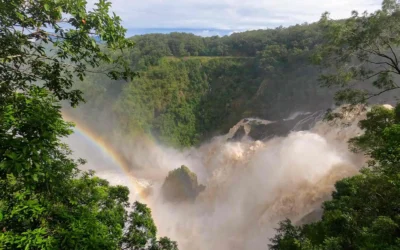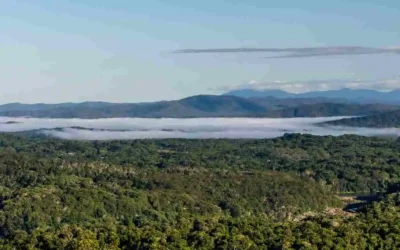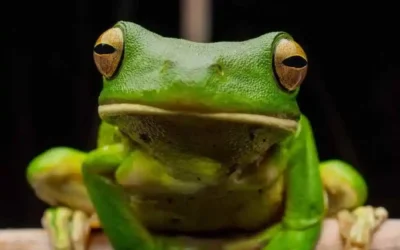Flowers and Seeds found in Australian Rainforests
Traditionally August is a dry month in Australian rainforests and this was reflected here in North Queensland.
Toward the end of the month we experienced some cloudy days and the occasional shower, but overall August was typically dry. September marks the official start of the main flowering event in the rainforest, but lately the weather has been pretty unpredictable and the flowering pattern has been affected as a result. August saw the final stages of fruiting for Briar Silky Oak and Celerywood, both trees putting on an extensive flowering display this year. Briar Silky Oak started fruiting in large numbers along the back line, but the numbers of observable fruits declined rapidly. Celerywood kept to more stable numbers that were easily trackable and clearly visable for more extended periods.
Briar Silky Oak has woody pods filled to the brim with flat papery seeds. They start out with a noticeable red tinge before going grey, just before the pods open and release the seeds. Celerywood has flat, black double berries that seem to stay on the tree for quite some time. It is fully possible that both of these trees will still be doing the same in September. White Eungella Satinash flowered in moderate numbers last month. The flowers are dull white and borne on round ball shaped structures. They tend to have a woolly appearance. The fruits are small red berries that attract a number of birds. These trees are not found below 50 metres and produce a useful structural timber.
Whitfield Ash flowered in disturbed areas at Skyrail Rainforest Cableway last month. The flowers are borne in large clusters on top of the tree and have five white sepals and five smaller purple petals. The fruits are cube shaped woody capsules covered in bristles and consisting of four distinct parts. The tiny flat seeds have papery wings which assist in dispersing them in the wind. The leaves are quite large and slightly curved around the edges and the trunk of the tree is distinctly white. Whitfield Ash is a typical pioneer tree with very little branching, a short life span, copious amounts of seeds and a tendency to prefer disturbed areas. Towers 7 and 26 at Skyrail as well as the beginning of the Kuranda re-vegetation corridor are good spots to see these trees.
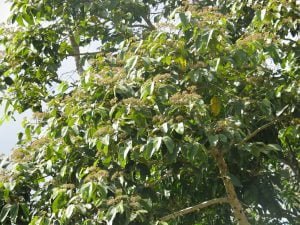
Whitfield Ash
Milky Silkpod is a woody vine that flowered in moderate numbers along the back line last month. The creamy flowers are borne on medium sized round platform shaped structures along the vine’s stems. Each flower has a nectary gland for attracting insects. The fruits are large sausage shaped woody pods filled to the brim with seeds and a silky plume attached. Lewin’s Honeyeaters use these silky plumes for lining their nests. The leaves are large and dark green and glossy with distinct nerves. These vines are the food plant for the caterpillars of the Hamadryad and the Common Crow Butterflies. Milky Silkpod has a relatively extensive range growing from sea level to 1200 metres and is found on various soils from North East Queensland to South East Queensland.
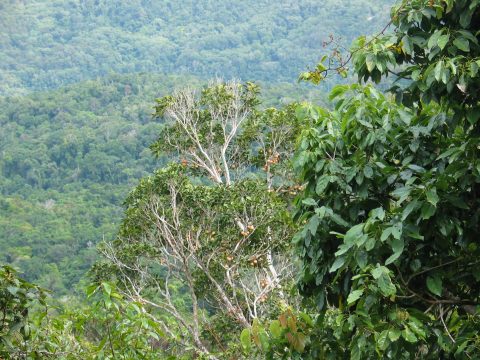
Kuranda Satinash
Kuranda Satinash, occasionally known as Brown Apple, started budding in small numbers along the back line last month. This tree flowers on the trunk, an adaptation for a closed canopy forest. The flowers look like small white shaving brushes. While flowering extensively, these trees attract nectar feeding birds and assorted insects. The fruits are dry brown drupes with one or two seeds. The leaves are a lance shape and have a waxy underside with no readily visible nerves. The trunk is usually beige coloured. Kuranda Satinash is a very strong tree and quite suitable for parks and larger gardens. In years gone by, the timber of these trees enjoyed a good reputation as a useful general purpose structural timber. Kuranda Satinash has a restricted distribution between Cooktown and Tully. Barron Gorge is one of the few places this tree occurs in large numbers.
Flora in Australian Rainforests – written by Skyrail Ranger Tore Lien Linde

